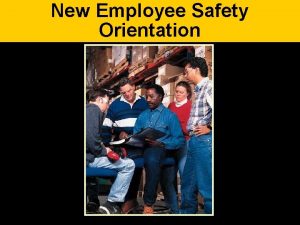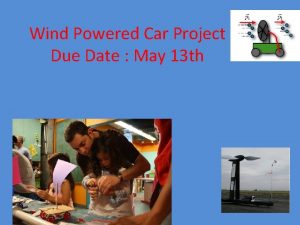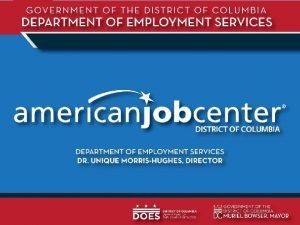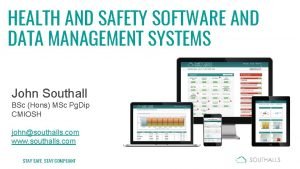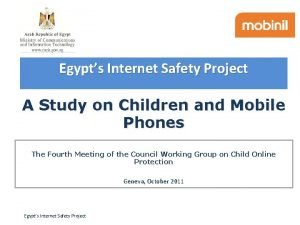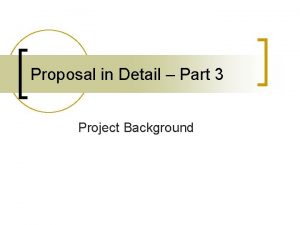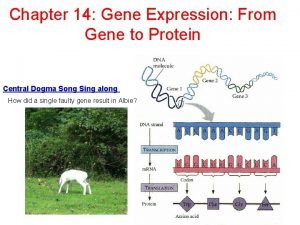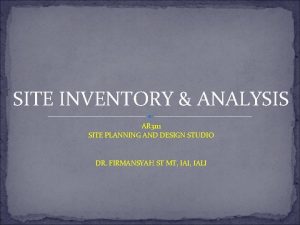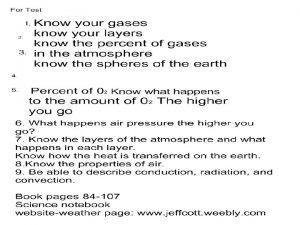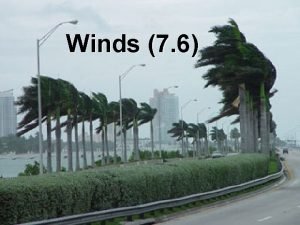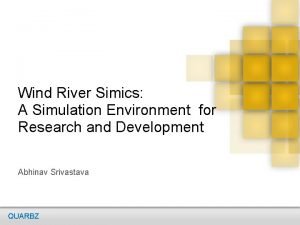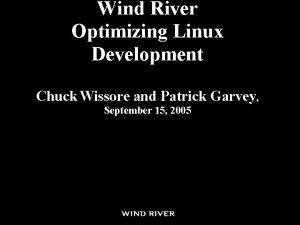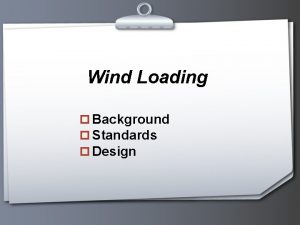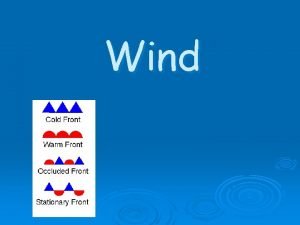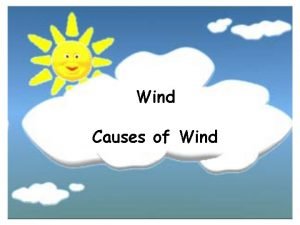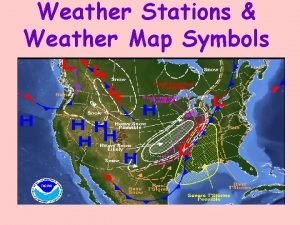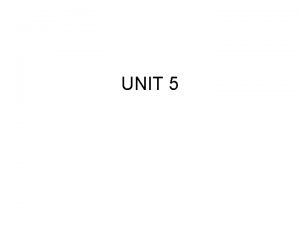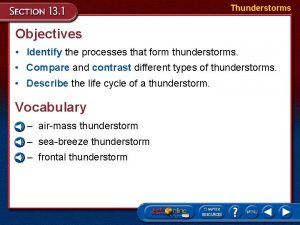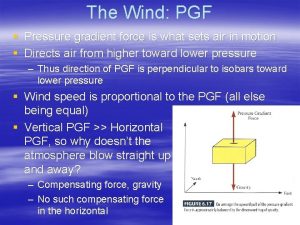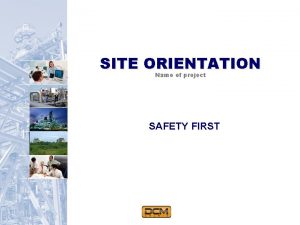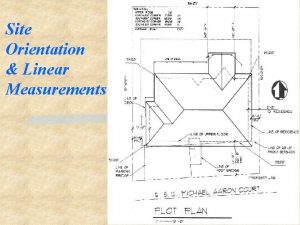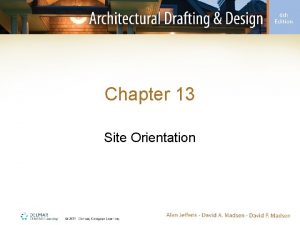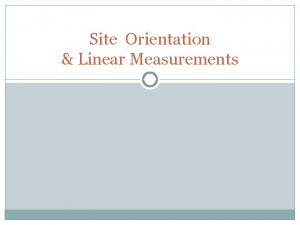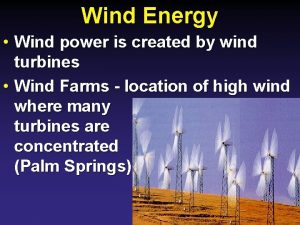SITE SAFETY ORIENTATION White Cloud Wind Project Site




































































- Slides: 68

SITE SAFETY ORIENTATION White Cloud Wind Project Site Safety Orientation

2 Today We Will… • Review key philosophy, principles, and fundamentals of SCS safety • Review site background, community, history, and any safety issues in the site environment • Review site rules • Site Safety Manager- Bubba Viator cell 720 -925 -2039

3 Safety Philosophy, Principles, and Fundamentals

4 SCS’s Safety Philosophy • Champion safety as our highest priority. Event free operation can only be attained if safety is reflected in every behavior – personnel safety, contractor safety, and public safety • Foster a safety culture in which everyone believes and demonstrates that accidents, injuries and illnesses are preventable and everyone understands their responsibility for maintaining such a workplace • Ensure personal accountability by employees and contractors in ensuring their safety, the safety of those working around them, and the safety of the public • Believe you can make a difference • Demonstrate a desire and commitment to continuously improve • We believe that employee and contractor safety are synonymous, as both hold the same responsibilities to ensuring we remain safe in all of our work environments

5 SCS’s Safety Principles • Employees are expected to take an active role in their personal safety • Safety incidents will occur, but through appropriate use of safety processes, procedures, and tools, future events can be prevented • As a company, we aspire to ensure employees return from work each day as healthy as they come • “Our work is never so urgent, nor our schedule so important, that work cannot be performed safely” • Uphold a “Zero Tolerance” culture

6 SCS’s “Zero Tolerance” Culture • Unsafe behaviors are corrected and coached immediately • Unsafe conditions are reported and corrected as soon as possible • Working any other way is not acceptable

7 Safety Fundamentals • Accept personal accountability for your safety and those working around you • All personnel are responsible for continually assessing their safety work practices • Focus on hazard identification/assessment then hazard prevention/control • Report all work-related injuries, illnesses, unsafe conditions or practices and near misses to supervision and site management

8 Safety Fundamentals (Cont’d) • Be responsible for your own safety • Don’t put yourself in potentially dangerous situations • Assess the hazards (Job Hazard Analysis Checklist will be covered this in more detail) • Be aware of your surroundings • Ensure a clean and uncluttered workspace (good “housekeeping”) • Identify potential for “events” • Slips, trips, falls • Struck or struck by (falling objects, sharp objects, etc. ) • Over exertion (lifting, pushing, pulling, reaching, twisting, climbing) • Cumulative trauma/repetitive motion • Control or prevent the hazard • Remove/disable the potential hazard • Change behavior or process to mitigate the hazard

9 Safety Fundamentals (Cont’d) • Know and understand SCS’s safety principles, human performance principles, and human error prevention • Leverage Human Performance Tools to enable you to be safer and create a safer environment for others • Utilize checklists, forms, and other tools (Job Hazard Analysis, Pre-Job Briefings, Tailgate Meetings, etc. ) if they apply and can help you create a safer environment • Consider and use the appropriate equipment and personal protection for any work • Conduct thorough investigations of incidents

10 Safety Fundamentals (Cont’d) All personnel should maintain a “questioning attitude” and always look to answer the 4 Critical Questions… • What are the CRITICAL STEPS in the task? • What are the ERROR LIKELY situations? • What is the WORST THING that can go wrong? • What DEFENSES are we relying upon?

11 Safety Fundamentals (Cont’d) Human Performance Tools • Self-Check (STAR) – Stop, Think, Act, Review • Peer Check • First Check • Concurrent Verification • Independent Verification • Workers Observing Workers (WOW) • Pre-Job Brief (PJB)

12 Safety Fundamentals (Cont’d) Self-Check (STAR) • Stop – Pause before performing your task, to enhance the attention to detail. Attempt to eliminate current or potential hazards. • Think – Understand specifically what is to be done before performing the task. Question the situation by trying to identify all information pertinent to the task or job. Determine if the task is appropriate for the given conditions and consider both the expected responses and results. Decide what contingency plans are required and get responses to any unanswered questions. • Act – Conduct the activity as intended or agreed to. • Review – Verify that the actual response is the expected response/result. Take the agreed-to contingency action is the actual response was unexpected.

13 Safety Fundamentals (Cont’d) Workers Observing Workers (WOW) • Observe yourself and your colleagues • Ensure employees and contractors take a personal interest in the safety of anyone working within an SCS facility • Actively provide feedback to anyone when unsafe behaviors and unsafe acts are observed (below are some suggested approaches) • Leverage humor to help coach any unsafe behaviors • Show you care about your colleagues’ safety • Assume they don’t realize what is unsafe about their behavior • Ask permission to provide some feedback on the situation or behavior • Positively reinforce those behaviors that are good • Lead by example

14 Safety Fundamentals (Cont’d) Pre-Job Brief (PJB) • Performed for all physical work activities • Purpose • Ensure all affected personnel understand the scope and expectations of a given work activity • Create an environment of open, candid communication where the work can be discussed and evaluated for all to understand • Conducted before the start of each job, and involves all workers that will be participating on the particular job • Cover at least the following: • Hazards associated with the job • Work procedures involved • Special precautions • Energy source controls • PPE requirements

15 Safety Fundamentals (Cont’d) Pre-Job Brief (PJB) – Cont’d • At least one PJB conducted before each day, or before a new shift begins work • Additional PJB shall be held if any significant changes occur which might affect the safety of the employee • Working alone does not prevent you from conducting your own, informal PJB, using the same evaluation criteria and elements • Site employees are responsible for ensuring that these are being held, and that they are being done correctly and appropriately (even if the contractor is leading and owning the PJB) • PJB should answer the “ 4 Critical Questions” (reminder below) • What are the critical steps in this task? • What are the error likely situations? • What is the worst thing that can go wrong? • What defenses are we relying upon?

16 Safety Fundamentals (Cont’d) • Pre-Job Brief – An Example of “What Good Looks Like” • PJB leader has adequately prepared for the PJB – knows the content, the hazards, and the work • PJB is done in an appropriate location that allows personnel to pay attention and hear the review • All required attendees are present and attentive • Brief properly covers • • • Job purpose, expected results, and scope Roles and responsibilities of personnel involved Human performance tools discussed and reviewed Actions and safe practices to prevent any errors and review of error-likely situations Review and discussion of potential hazards Review of communication requirements Review of any safety or environmental requirements Discussion of conditions that would result in work stoppage or supervisor notification Review of any lessons learned from recent or similar jobs Review, and answer of the 4 “Critical Questions” • PJB leader does not employ a sense of urgency that promotes the atmosphere of time pressure to complete the task • PJB leader solicits participation

17 Site Background, Community, History, and Environment

18 Site Background and History Site currently used for agricultural farm land. Site workers should be aware of local agricultural activities. Known hazards include farm equipment, spray from pesticides, herbicides, fungicides and fertilizers. Always stay upwind of any spray activities Steep drainages ditches along roadways. Gravel roadways with heavy equipment traffic.

19 Community Relations • Maintain a “Good Neighbors” perspective • Observe speed limits (beyond limits already in place at the site) • Maintain respect for the land natural preserves in the area • Act in a professional manner, representing your company, and SCS, in a positive light with the local community • Avoid backing up in non participants driveways • Protesters / Media • Do not engage • Call an SCS/ ENEL representative or your supervisor

20 Environment and Safety • Insects and spiders in the area • Deer Tick • CDC is predicting a record high this year • Brown Recluse Spiders Deer Tick

21 Environment and Safety (Cont’d) • Best method of removal • Attempt to remove tick or critter with tweezers • Do not leave the head • Apply antibiotic • Seek medical treatment if rash or swelling occurs • Keep the tick for the medical examiner • Spider nesting can often be found in or under: • Conex boxes • Pallets • Office boxes • Wooden pallets • Delivered or stages supplies and equipment • Wooden spools • Port-a-potties/Check under the seat • Typically warm areas

22 Environment and Safety (Cont’d) • Snakes • Rattlesnake • Found near wetlands during spring • Move upland to “Sun” themselves • Hints for avoidance • Keep watch in high vegetation • Avoid them if seen • Rattlesnakes will avoid contact • Do not harass or approach • Deer • Watch for deer coming out of ditches • Crossing wooded areas • Leaving fields

23 Extreme Weather • Always be aware of the weather conditions, and the weather forecast, at your site and in your work area • Site management makes weather-related “Stand Down” determinations, BUT… • All personnel have an obligation to stop work if extreme weather is observed and they have not yet been notified by site management Lightning • Work will not be done in or around wind turbines during lightning storms • A lightning strike within 30 miles of the wind turbine will constitute a “Stand Down”. Civil will “Stand Down” when lightning is within 15 miles of site. • Workers observing lightning or who are notified by their supervisor of a lightning strike will assemble according to the site emergency evacuation plan • “Stand Downs” will last 30 minutes past the last lightning strike within 30 miles of the wind turbine , 15 miles for civil or longer if deemed necessary by site management

24 Extreme Weather (Cont’d) • High Wind • Weather monitoring should be conducted during all work in progress • Work in progress should be halted prior to wing speeds reaching the limits mentioned below if the wind speeds are increasing and/or are forecasted to achieve or exceed the limits mentioned • Limitations mentioned are guidelines – more specific wind speed limitations can be obtained by site management for the given turbine manufacturer

25 Extreme Weather (Cont’d) • Tornado • Unlikely in this area of the country • There are no storm shelters in this area • Seek refuge in low lying areas such as a ditch • Do not shelter in vehicles, equipment or trailers. • Ground Fire • Range, grass, crop and forest fires can be fast moving and endanger personnel working on or near sub’s and T-Lines • Air quality should be taken into consideration when fires are present • Any ground fires shall be reported to site management immediately

26 Site Safety Rules

27 Basic Site Safety Rules • Personnel on site must be 18 years or older • No pets and/or children • No firearms/weapons/knives allowed on site • Illicit drugs and paraphernalia are prohibited • Alcohol is not allowed • Smoking/tobacco use only in designated areas • Ensure you are fit for duty • Obey all signs/posters and barricades • Jewelry and/or loose clothing not permitted • No horseplay/running/fighting • No reckless driving in snowy, icy, or muddy conditions • All personnel have a right to refuse unsafe work • All personnel have a stop work obligation

28 Basic Site Safety Rules (Cont’d) • Maintain good housekeeping • Speed limit when passing houses is 15 mph and 25 mph on county roads • Speed limit in lay down yard area is 5 mph • Training records and attendance are maintained on site and available to SCS • • upon request • Personnel shall only perform tasks upon which they have been trained to perform safely • Additional training see your supervisor or safety representative. All visitors report to the SCS site office Visitors receive Orientation Site Specific Briefing • Must be accompanied by a representative from the company they are visiting who has completed orientation All incidents are reported & investigated Site maintains a post-accident Drug and Alcohol screening process

29 Basic Safety Rules – Substance Abuse • SCS reserves the right to have drug and alcohol screenings conducted in the following times: • Pre-Access – within 30 days of starting work on an SCS Project • Annual – for project lasting more than 12 months • Post Incident – after any incident that causes serious personal injury to self or others, property damage in excess of $1, 000, or motor vehicle accident as defined by the FMCSA. • Reasonable Suspicion – as observed by contractor or SCS management • Unannounced – any or all site employees at the sole discretion of SCS Random – as required by DOT, other laws or the contractor policy

30 Basic Safety Rules – Substance Abuse (Cont’d) • Prescription drugs and over the counter (OTC) medications are permissible if the following conditions have been met: • Prescription drugs have been prescribed by a licensed physician for the person in possession of the drugs • The prescription is not expired and was filled by a licensed pharmacist for the person possessing the drugs • The individual notifies their supervisor that they will be in possession of or using, impairment-causing prescription drugs or OTC substances and appropriate steps are taken to accommodate the possible impairment • SCS may also require the Contractor to conduct a search or inspection of any person on-site to include any vehicles or containers for alcohol, drugs or paraphernalia

31 Basic Safety Rules – Housekeeping • Contractors required to provide: • Containers (dumpsters) • Collection, separation, and elimination of construction waste • Please use your own waste containers and not other company’s • Work areas policed daily and as work progresses • Scrap/reusable lumber stored neatly • Nails/screws removed • Containers for garbage or oily waste must have covers

32 Basic Safety Rules – Housekeeping (Cont’d) • Spills • Each contractor must have a spill kit (where is yours? ) • Spills stopped / contained immediately and reported to SCS Safety Dept. according to SPCC plan • In accordance with state and county 110% of spoil taken out and properly disposed with cradle to grave receipt.

33 Basic Safety Rules – Safe Driving • No personal vehicles are allowed in work areas; only company vehicles and rentals • Must be labeled with company name or logo • Drivers must be: • Licensed • Medically fit • Well rested • Observant and adjust driving to prevailing road conditions • Not under the influence… • Passengers • Number of passengers does not exceed manufacturer’s specifications for the vehicle • Functional seat belt for each passenger • No persons permitted to ride in bed of pick-ups, trailers, etc.

34 Basic Safety Rules – Safe Driving (Cont’d) • Cargo/Loads • Vehicles not loaded in excess of manufacturer’s specifications • All loads secured to prevent displacement • Loads do not extend beyond vehicle boundaries unless: • Flagged, lighted, pilot vehicle, ground guide, etc, • Seat Belts • Worn by driver/operator and all passengers • Driver’s responsibility • Mobile Phones/Radios • No two-way communication while driving, operating equipment, etc • Exception for radio use for crane/equip operators • Pull off road to take call or leave work area • Bluetooth devices are permissible in vehicles…not equipment or while working

35 Basic Safety Rules – Safe Driving (Cont’d) • Vehicle Maintenance • Ensure that vehicles and equipment are of good, sound working condition • All passenger vehicles driven to and on the jobsite must be street legal and current on registration, inspection and insurance • Motorcycles • Only to be used for commuting to and from the lay down yard / office parking lot and not ridden into work zones or tower areas.

36 Basic Safety Rules – Stop Work Obligation • Every worker is authorized and, has the obligation to STOP WORK for unsafe acts and/or conditions • Every worker has the right to refuse an unsafe Work Order • Does not matter who, what, where, or when • You see it – you own it; safety is all of our responsibilities • Uphold a “Zero Tolerance” culture

37 Safety/Planning Meetings • Several safety meetings to be held on site and enable a safe environment • Plan of Day (POD) – Contractor and SCS site management. Meet daily to • • discuss work to be performed that day. Tailgate or Toolbox meetings – Supervisors and personnel. Meet weekly to discuss work and safety concerns. JHA Review – Supervisors and personnel. Conduct prior to beginning the day’s work, or beginning a new task; discuss the specific task and safety work. All Hands Safety Meeting –Wednesday at 7: 00 am/All site personnel. Meet weekly to receive safety message from Project Manager. Safety Team Meeting – Site Safety Leads. Meet weekly to discuss trends and focus efforts of site observation and inspection programs.

38 Job Hazard Analysis (JHA) • Ensure that any JHA involves personnel that have valuable input. These can include: • Supervisors • Workers who have performed the task previously • Subject matter experts (e. g. training specialists) • Break down the job into its basic steps or tasks • Describe the sequence of steps to ensure clarity among all workers for the particular job • Balance detail appropriately - each step should accomplish a major task • Identify hazards, ensuring the use of past experience to help inform hazard identification

39 Job Hazard Analysis (JHA) – Cont’d • Potential sources of hazards include: • Line of Fire • Material Handling, Walking and Working Surfaces • Industrial Hygiene • Ergonomics • Energy Isolation • Hazardous Materials • Fire • Weather • For each hazard, list the measures to be taken to protect the worker from the particular hazard. These could include: • Engineering controls (e. g. barriers and guards) • Administrative controls (e. g. written procedures) • Use of PPE

40 Job Hazard Analysis (JHA) – Cont’d The JHA can be accessed with your smart phone or tablet. On your smart phone go to www. scssafe. com , then project tab. Scroll down to your current job site and select the site. Click the blue tab in the “Job Hazard Assessment (JHA)” section and fill out the form and click submit at the bottom.

41 Line of Fire • Line of Fire – when a person places their body or body part in a position where they can be struck, sprayed, cut, burned, pinched or punctured. • To avoid Line of Fire incidents: • Visualize the tasks you and others are about to perform • Place body parts in positions that cannot be cut, struck sprayed, etc. • Do Not stand or walk under a suspended load or overhead workers • Cut away from your body (Use cut resistant gloves) • Always use doorknobs or handles, do not hold on side of doors/drawers • Anticipate what could be struck and if you or others are in the Line of Fire • Ask “What is the worst thing that can happen? ”

42 Personal Protective Equipment (PPE) • Minimum PPE while on the job site is as follows: • Approved safety glasses with side shields • Use zero-tint (clear) safety glasses when working in an indoor work • • • environment unless tints are required for the task Hard hats • No inappropriate/vulgar stickers • Hard hats must be worn with bill facing forward Safety Toed foot wear High visibility vest, shirt or jacket • Must be work at all times outside of any building, trailer, etc. (even in the parking lot) Gloves, face shield, etc. dependent upon job hazard analysis (JHA), and your company policy above and beyond JHA Cut proof gloves must be used for any job using a knife or potential for hand cuts.

43 Personal Protective Equipment (PPE) – Cont’d • Minimum PPE (cont’d) • General construction attire consisting of natural fiber garments (sleeve length minimum 4”, long pants, or coveralls) • For climbing at heights: • Safety harness including: • Personal full-body fall arrest system • Rated safety lanyard with 100% tie off capabilities • Side D Rings/Hip Pads • Front D Ring • Suspension trauma straps / stirrups • Gloves approved for work being performed • Hard hat or Petzl style helmet • Additional PPE may be required by supervisor or as work conditions require (e. g. hearing protection in all designated areas and/or where noise levels are greater than 85 d. B)

44 Equipment This equipment doesn’t have a brain, so please use yours!

45 All Equipment Including Cranes, Rigging and Lifting • All operations comply with Manufacturer’s specifications • No additions and/or modifications without Manufacturer’s approval • Equipment must inspected daily prior to operation or tag out of service if defects are found. • Cranes & rigging inspected by competent person • Daily Crane Inspections – Documented • All rigging tested, examined, certified (documented) • Annual inspection documented and submitted to SCS prior to use • All rigging inspected prior to each use • Manufacturer’s Handbook in cab • Qualified/Certified operator documented

46 Equipment – Cranes and Lifting (Cont’d) • Tag lines used on all lifts • Operation > 10 feet from energized power line • Operator is in cab when load is hoisted • Crane hooks must have safety latches • One qualified Signal Person per operator • Operator obeys stop signal from anyone • Hand signals (or radio communication) shall be per the applicable ANSI standard

47 Equipment – Cranes and Lifting (Cont’d) • Fire extinguisher (5 BC or greater) in cab • Cranes traversing public roads must have escort • Cranes must have a spotter when walking • Barricades must be in place for lift zones • Swing zone must be barricaded or designated spotter in place • No unauthorized entry into lift zones or passing through without the lift supervisor’s permission • Unauthorized personnel must be out of fall area until secured

48 Signs, Signals, and Barricades • Signs and warnings shall be in the local language and/or use pictorials to communicate hazard • Red and white signage (may have black writing in it) identify a “DANGER” hazardous area that should not be crossed. Unauthorized access may result in death or serious injury. • Orange signage (may have black in it) identify a “WARNING” hazardous area that should not be crossed. Unauthorized access may result in death or serious injury. • Yellow signage (may have black in it) identify a “CAUTION” hazardous area. Unauthorized access may result in minor to moderate injury. Caution signs may also be used to alert to unsafe practices.

49 Signs, Signals, and Barricades (Cont’d) • Contractor/Subcontractors responsible for erecting any signage shall indicate the hazard, name of the Contractor/Subcontractor, and name of person erecting the signage • Observe and adhere to all warning signals and barricades • Properly post/erect signs, signals or barricades to advise personnel of hazardous conditions in work areas • Barricades shall be constructed to withstand adverse weather conditions and construction traffic • Rigid barricade constructed of wood or similar material shall be erected when excavating next to roadways, sidewalks, driveways, other heavily traveled areas, or where site conditions warrant. • Orange plastic safety fencing with t-post should also be used around foundation excavations.

50 Fire Prevention and Protection • Employees should be trained to recognize fire hazards • Keep combustible and flammable materials away from ignition sources • Maintain clear access to fire protection equipment and emergency exits • Do not refuel equipment while it is running or hot • Smoking is only permitted in designated areas (never in buildings or enclosed areas) • Ensure engine exhaust away from vegetation and a portable FE in all on-site vehicles We don’t expect you to be a fire fighter; know your limitations

51 Fire Prevention and Protection (Cont’d) • Ensure vegetation does not accumulate under vehicle • Employees expected to use fire extinguishers shall be properly trained in use, capabilities and limitations • Fire extinguishers shall be readily available in all work areas • Fire extinguisher (20 B) < 25’ from any portable gas powered equipment • Fire extinguisher (20 B) < 10’ from any door for inside storage of flammable Material • Fire extinguisher (20 B) 25 -75’ feet from outdoor fuel storage • Fire extinguishers shall be inspected monthly • All work vehicles shall have a fire extinguisher • Portable storage (greater than 60 gal) double walled or 150% secondary containment and grounded

52 Hot Work • All hot work shall be done in accordance with a hot work permit • A trained fire watch shall be used when hot work is performed • Combustible and flammable materials shall be removed from the area prior to the start of any hot work • Employees assigned as fire watch shall have a fire extinguisher readily accessible • Fire watch duties shall extend 30 minutes after completion of hot work

53 Working at Heights • Guardrails of standard construction are the preferred method of fall protection • Use fall protection equipment at unguarded heights greater than 4 feet or where the employee is subject to any fall which could cause injury, such as, working over dangerous equipment or over swift moving water. To include: • Unguarded/ leading edges • Wall and Floor openings

54 Working at Heights (Cont’d) • When guardrails are not present or are not of standard construction a personal fall arrest system is required. • ABC’s of Personal fall arrest systems: • Anchor point designed to with stand twice the intended load or 5000 lbs • A full Body harness meeting the requirements of ANSI 359. 1 • Connectors such as lanyards, retractable lanyards, or ladder safety devices that are compatible with the other components in the system • Employees shall have training necessary to: • Identify potential fall hazards • Select appropriate fall protection devices • Don and doff the equipment • Perform the daily or pre-use inspection • Select the proper ladder for a job and use it correctly

55 Working at Heights (Cont’d) • Ladders • Select the proper ladder for the task to be performed • Use the ladder according to its design and within limitations • Use ladder safety devices on fixed ladders as provided • Maintain three points of contact at all times • Extension ladders extended 3 feet beyond landing • Exception within the nacelle but must be tied off • Do not use top two rungs of step ladders • Extension ladders – 4: 1 rule • Portable wooden and metal ladders are not permitted • Inspect before use • Properly stored when not in use • Portable ladder class 1 A and class 1 AA are only allowed on site

56 Excavations • The Competent Person for excavations shall determine what is needed to • • complete safe excavation work Excavations shall have an Excavation permit along with an Excavation Log A soil check should be a prime factor to determine whether to shore, slope, or step back or utilize a trench protection system A study of flood level and tidal changes will also be a factor in determining if a water hazard exists and if a dewatering system is needed Prior to any excavation, an effort shall be made to determine whether underground installations (i. e. sewer, telephone, water, electric, etc. ) will be encountered. • Utility companies shall be contacted and advised of proposed excavation work prior to the start of actual excavation

57 Excavations (Cont’d) • Additional shoring or protection shall be used when there is a risk of cave-in, • • fall-in, or collapse Open excavations shall be barricaded with diamond-weave plastic fencing Walkways, bridges, crosswalks, and roadways shall be provided as needed and shall follow the standard guard rail requirements Proper access and egress into any trench four feet or more in depth will be provided and maintained, and shall be located at intervals no more than 25 feet lateral travel A competent person shall inspect excavations on a daily basis, or more frequently when additional hazards are present

58 Confined Space Entry • All confined spaces, including both “permit-required” and “not permit required”, shall be properly labeled • A Confined Space is a space that contains all of the following: • Is large enough for an employee to enter and perform the assigned work • Has limited means of access and egress • Was not designed for continuous occupancy • A permit is required for any confined space that has one or more of the following criteria: • Contains or has a potential to contain hazardous atmosphere • Contains a material that has the potential of engulfing an entrant • Has in internal configuration such that an entrant could be trapped or asphyxiated by inwardly converging walls or by a floor which slopes downward and tapers to a smaller cross-section • Contains any other recognized serious safety or health hazard

59 Confined Space Entry (Cont’d) • Work performed in a Permit Required Confined Space (PRCS) shall be done in accordance with the permit • All PRCS work shall be done with a trained attendant stationed outside of the space • A copy of the permit shall remain posted in the work area for the duration of the entry • A qualified rescue team must be available whenever entry into a PRCS is made

60 Electrical Safety • All equipment should be locked out to prevent unexpected startup or the release of stored energy • Equipment not capable of lockout may be tagged out if a formal procedure for control of tags is in place • LOTO guidelines: • Approvals – LOTO must be approved by site management and done in conjunction with an approved plan for isolating affected energy sources • Installing Locks – all personnel affected by the LOTO will install a personal lock in the event a lock system is used • Locks and Tags - will be durable, standardized, substantial and identifiable • Forms – all personnel involved must read the LOTO and sign on and off the LOTO form

61 Hazard Communication • All chemical hazards shall be communicated with employees through a comprehensive program including labeling, safety data sheets (SDS) and employee training. • Employees will be informed by the site management or supervision of new hazardous chemicals being introduced into the work environment in which they will be exposed. • All chemical containers brought onsite shall be properly labeled with: • Chemical name • Manufacturer name and contact information • Hazards warnings • Employees shall review the Safety Data Sheet (SDS) for any new chemical prior to initial handling or exposure to the chemical.

62 Hazard Communication (Cont’d) • Copies of the Contractor SDS are to be maintained at the main site office • All personnel shall be provided with Hazard Communication Training prior to initial assignment and as frequently as needed to ensure understanding and compliance with Hazard Communications

63 Medical/First Aid • Contractors must arrange for a competent medical/first aid care to anyone who may be injured in connection with his or her work • Where Emergency Medical Services are not immediately available (i. e. within 7 minutes), contractors must establish a trained, properly equipped medical response available during work hours to respond to a medical emergency on the project • SCS will have at least one employee with a current First aid, CPR/AED certification and access to a standard first aid kit. This will not meet the requirement for contractor employees’ access to emergency medical services. • Enel has supplied an onsite Paramedic (GEMS). • To contact the Medic call : 505 -697 -2161

64 Bloodborne Pathogens • What is it? • …. . pathogenic microorganisms that are present in human blood and cause disease in humans. These pathogens include, but are not limited to, hepatitis B (HBV), hepatitis C (HCV) and human immunodeficiency virus (HIV). • Only trained employees shall administer 1 st Aid whereby pathogens reasonably exists. • 1 st Defense: Distance. When at all possible, have injured clean their own wounds, apply compresses, clean up spilled body fluids, etc. • 2 nd Defense: PPE. Latex gloves and micro-shields with one-way valves in all primary 1 st Aid boxes.

65 Accidents and Incidents 48 HRS 24 HRS 8 HRS START 48 HRS 5. SR Management – reviews the results and identifies if any further corrective actions should be incorporated 6. Safety Director– receives final report and associated information 4. Safety Professional – receives the electronic report and information and reviews for any additional questions or corrections 3. Site Management – reviews the information for the incident report and submits the information through the system 2. Site Safety – receives notice that an event occurred, and helps collect information for the incident report 1. Event – A safety event occurs in the site or facility END 7. Safety Alert– generates a safety alert email that goes out to all sites to help share in any lessons learned

66 Removal from Site • Zero tolerance for blatant, willful violations of company policies regarding certain aspects of: • Fall protection • Excavation and trenching • Lockout/tagout(LOTO) • Confined space entry • Motor vehicle operation or equipment operation • Crane and erection safety • Working near energized power lines without proper safeguarding • Drugs and/or alcohol abuse • Not tied off on top of nacelle or inside of hub • Fighting • Abuse of landowners

67

68 Questions? Our work is never so urgent, nor our schedule so important, that work cannot be performed safely.
 00101-15 basic safety
00101-15 basic safety 00101-15 basic safety
00101-15 basic safety Raumschotkurs
Raumschotkurs Difference between polycentric and regiocentric
Difference between polycentric and regiocentric White sheep white sheep on a blue hill meaning
White sheep white sheep on a blue hill meaning Ellen g white biography
Ellen g white biography Employee safety orientation quiz answers
Employee safety orientation quiz answers New zealand official languages english
New zealand official languages english Computing refers to
Computing refers to Cloud integration patterns
Cloud integration patterns Public cloud vs private cloud cost analysis
Public cloud vs private cloud cost analysis Share data
Share data Wind powered car project
Wind powered car project Hot site cold site warm site disaster recovery
Hot site cold site warm site disaster recovery Project empowerment orientation registration
Project empowerment orientation registration Southall safety cloud 2
Southall safety cloud 2 White paper project
White paper project What is catzoc
What is catzoc Safety care 2 person stability hold
Safety care 2 person stability hold Personal safety vs process safety
Personal safety vs process safety Ind safety report
Ind safety report Helmut-schmidt-universität
Helmut-schmidt-universität International satellite cloud climatology project
International satellite cloud climatology project Internet safety project
Internet safety project The role of project management in achieving project success
The role of project management in achieving project success Background project example
Background project example Iteration workflows in software project management
Iteration workflows in software project management Project cost duration graph
Project cost duration graph Introduction to project management kathy schwalbe
Introduction to project management kathy schwalbe Project evaluation in software project management
Project evaluation in software project management Traditional vs modern project management
Traditional vs modern project management When conducting post project audits
When conducting post project audits Process indicators enable software project manager to
Process indicators enable software project manager to Agile ms project template
Agile ms project template Example of theoretical framework
Example of theoretical framework Types of project termination
Types of project termination What is a site and p site of ribosome
What is a site and p site of ribosome Ar
Ar Untangle vpn
Untangle vpn What is the horizontal movement of air called
What is the horizontal movement of air called Why are they called horse latitudes
Why are they called horse latitudes Global wind belts
Global wind belts What does anemometer look like
What does anemometer look like West north west wind direction
West north west wind direction Wind belts
Wind belts What is meant by “the wind is backing”?
What is meant by “the wind is backing”? Windriver simics
Windriver simics Wind river linux commands
Wind river linux commands Wind load calculation example bs 6399
Wind load calculation example bs 6399 Abrasion wind erosion
Abrasion wind erosion What creates wind
What creates wind Abrasion wind erosion
Abrasion wind erosion What creates wind
What creates wind Classification of wecs
Classification of wecs What causes wind
What causes wind Wind by ted hughes analysis
Wind by ted hughes analysis How are deserts formed
How are deserts formed What makes wind blow
What makes wind blow Desert sky wind farm
Desert sky wind farm Wedding wind philip larkin
Wedding wind philip larkin Weather station model symbols
Weather station model symbols Force 8 wind
Force 8 wind What causes the wind to blow
What causes the wind to blow Touchdown zone markings
Touchdown zone markings What type of figurative language is this
What type of figurative language is this Compare and contrast cold wave and wind chill factor
Compare and contrast cold wave and wind chill factor Aos.wisc.edu
Aos.wisc.edu Pgf force
Pgf force Nature of the wind
Nature of the wind






